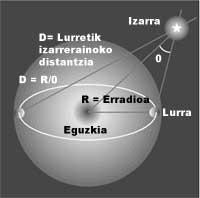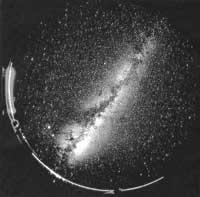HIPARCO
Just spacing in 1989, the satellite suffered a breakdown in the ignition system of the apogee engine, which prevented it from circulating in geostable orbit, although it was designed for it. The functions of Hiparco have had to adapt and in another orbit, with an apogee of 36,000 kilometers and a perigee of 500 kilometers, it has been working three years. The Hiparko satellite takes advantage of seventeen hours a day and not twenty-four. However, the satellite is fulfilling its functions perfectly.
Revolutionary data
As scientists analyze the set of data sent by Hiparco, they are surprised again and again and believe that the fundamentals of astrophysics and cosmology must change. They say that in astronomy the post-Hiparco era begins. It will take ten years to capture data sent by the satellite and adapt our theories.
In fact, the satellite has not suffered disturbance due to the terrestrial atmosphere and gravitation when it has calculated the distances to the stars. It has measured distances and movements of approximately 118,000 stars, 10-100 times more precise than the terrestrial surface.

To choose which stars to measure, proposals have been received from over two hundred astronomers and have been included in our list as the Sun, white dwarfs, red giants (like the star Betelgeuse), unstable stars (like the Mira), the quasar 3C273, 48 asteroids, Titan and Japanese satellites of Saturn, the satellite Europa of Jupiter, etc. exist.
The distances of more than 300 stars taken as a pattern have been recalculated, reaching an order accuracy of 1%. The other 21,000 stars will also adapt their distances in this new celestial map, with a distance error of less than 10%. So far, astronomers only had that precision for a few hundred to measure distances. But thanks to Hiparco's data, the star catalogue will be much more reliable and accurate. In addition, the new catalogue is leaving the mouth full of astronomers.
Trigonometric parallax
He was a Greek astronomer called Hiparko. He measured for the first time the distance towards the stars of the sky towards the year 120. Its most important measurement was the distance from Earth to the Moon. For this purpose, he used the system called trigonometric paralysis. The same star is measured six months from the Earth. During this time the Earth travels around the Sun to the other end of its orbit and the star being investigated has modified its position in the sky.
To measure the distance, a theoretical triangle is taken. The base of the triangle is the diameter in orbit of the Earth (300 million kilometers) and can be calculated the angle at which the star has apparently been “displaced” in the sky. With the angle so measured, the distance from Earth to the star by trigonometry is easily calculated.
Through this system, the celestial map formed by Hiparco was based on angles measured at a glance and the accuracy was one minute of degree. Now, twenty-one centuries later, the precision used by the Hiparko satellite is 30,000 times higher.
Solitary solar system
The Hiparko satellite confirms what we already knew from measurements made from Earth: our Solar System is only in a “desert” of the Milky Way. The light emitted from the star closest to the Sun (Alfa Centauri) takes more than four years to reach us and six years to reach it the star Barnard. In addition, more than 40% of the 1,500 stars considered close to the Sun (more than 85 light years) are at a distance much higher than 40%.
The distance to the star and its apparent brightness are the basis for the calculation of other parameters. Hence the surface temperature of the star, its chemical composition and the type of star, that is, like the Sun, if it is a red giant, a white dwarf or other type. Therefore, if Hiparco has decided that the distance is different, the opinion of astronomers about some stars will change. In addition, the data of some stars served as a pattern to calculate the distance to other stars, and from now on everything will change.
New celestial map

Another surprise has been the detection of multiple stars. Where astronomers only saw an astronomer, Hipparchus double stars, triples, etc. have detected them. Although constant brightness stars were detected with Earth's devices, in many cases (around 6,000) the satellite has determined that they are stars of variable brightness. Hiparco has also thoroughly studied the Cepheids, which periodically change their brightness. Data from these stars have been used to calculate the distances between galaxies and stars. But thanks to the Cefeids, the relative distances between galaxies are calculated mainly, that is, the distance between them. Accordingly, given some complex steps, you can obtain the age of the Universe.
However, the distances between the data of Hiparco and the galaxies should be recalculated and without great errors, it can be affirmed that the data used so far on the age of the Universe will be uncertain. Hiparco has shown that the Sun curves the rays of light and has confirmed the general theory of relativity, but it is not surprising that it has to change the Hubble constant, based on the distance between the stars.
Hiparco's data will be delivered first to scientists who have participated in this space project and the official catalogue will be published in May 1997. They will then be available to other scientists and astronomers.
However, Europe will send the successor of Hiparco, the satellite Gaia, before 2015. This interferometric satellite will detect 50 million stars and the accuracy of the measurements will be about microseconds of degree, that is, 100 times higher than that of Hiparko. The entire Milky Way can be measured and mapped to the Magellanic Clouds.





